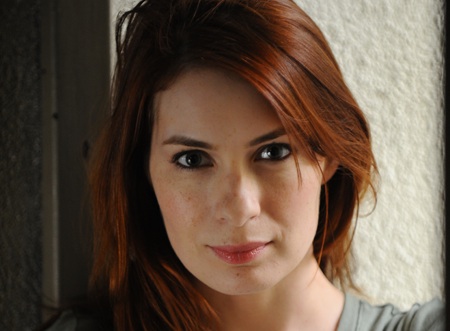 Back to selection
Back to selection
A FINAL REPORT ON SXSW INTERACTIVE 2011
 FELICIA DAY
FELICIA DAY My mind wasn’t blown this year. No Zeitgeist-nailing speaker convinced me that the world was about to change. Nor was there a high-profile washout, a speaker whose on-stage fail created its own newsworthy drama. I’m talking about SXSW Interactive, the mammoth convention/trade show/meet-up/party spot that crowds the stage with the more homespun SXSW Film in Austin each year.
This was my fifth SXSW, and, a couple of years ago, in the midst of the indie film depression, I realized something. The positive energy, the feeding frenzy, the dollars — most of it was over on the interactive side. The kind of people who might have tossed some coin into the indie film investment pool — they were funding apps. And, in terms of the panels, while the film industry droned on about distribution and DIY in rooms holding 200 or 300, the interactive folk were discussing big issues like consciousness and ethics and things costing billions of dollars in rooms holding two or three thousand. A couple of years ago more than that many people crowded several rooms to hear Chris Anderson evangelize his “free” credo. (Okay, Anderson’s “free” schtick wound up just being promo material for a book sold at airport bookstores, but we didn’t think that at the time.) Last year I witnessed Twitter CEO Evan Williams’s shockingly dull and non-newsworthy Q&A — a misfire that seemed important just by underscoring how much the Twitter community, not its founders, have defined the value proposition of this now essential service. But more than compensating last year was MIT’s Danah Boyd, whose talk on privacy and participation in the digital public square was simply brilliant. And there were product milestones in years past too. In 2007, the relatively new Twitter tripled its usage during that one week in Austin, and Foursquare took off at 2009’s fest.
In terms of products and platforms, 2011 was a year of further growth and maturation. Indeed, as Louis Gray notes in his blog, the “SXSW winners” were Foursquare (again, as the company rolled out a new version and added SXSW-specific badges) and Hashable. Or, as one person said to me, “SXSW this year was all about the iPad 2.” I wouldn’t go that far, but Apple’s pop-up store on Congress, just a black down from the Paramount and State theaters, attracted round-the-block lines, and new owners did more than a few on-the-spot demos in the days following at the Convention Center. One tech panelist told me that the one new application he was impressed with had something to do with “contextual wi-fi” — it signs you in and out of applications and services depending on where you are.
“Contextual” was one of two buzzwords I heard bandied about in Austin last week. The other was “gameification,” and it was the subject of the Interactive conference’s opening keynote by 22-year-old Scvngr head Seth Priebatsch. Briefly, “gameification” refers to the idea that game design and game mechanics will soon come to inform our social and business lives. And if the past decade was all about “social,” then, said Priebatsch, the next decade will be about the game layer. “The game layer can be ten times larger than it is today,” he said, “and we need to think about it before its structure is decided. We want it to do what we want it to do.” The “game layer” acts on “individual motivation,” Priebatsch said, and his presentation consisted of examining how intelligent use of the game layer could address five different real-world problems. The first is education. “School is a game, but it is a poorly designed one,” said Priebatsch, while noting that he himself had dropped out of Princeton. “It’s a badly designed game, but it’s the best example of a game system [in real life]. You have motivated players, challenges, rewards, levels, enemies and allies. But there are problems. There are students who are not engaged, who show up late and check out early. The grading system is broken, and there is cheating.” Priebatsch suggested using “experience points as a replacement for grades — a progression dynamic.” He said traditional grades have created “a moral hazard of gradeplay.” Grades are arbitrary letters, and they only represent a moment in time — i.e., how someone did on a particular test as opposed to the sum or their experiences. He also discussed an anti-cheating program at Princeton that worked by “subtly shifting the design of the game.”
Next up was a discussion of the problem of “customer acquisition.” How do companies attract new customers? He discussed location-based services like Foursquare and Groupon, identifying game-like aspects (the “countdown dynamic,” the “level up” and the justified “free lunch”) that worked and could even be enhanced further. He talked about “reward schedules” — how they’re the “moral hazard” of location-based services (people don’t check in unless they think they’ll get something) and how they might be improved. He also discussed “quantitative easing” — no, not Fed monetary policy but making the rules of the game less restrictive. “The Fed does it when the game has become too hard,” Priebatsch quipped.” Identifying the problem with location-based services — you have to be at a place in order to participate, limiting the number of players — he proposed these services allow “loosely location-based engagement.” In other words, you can check-in to a place from afar.
In his final discussion, which took the form of a game itself, Priebatsch talked about how the game layer could solve global warming. Well, not really, but sort of. Identifying three compelling qualities of a good game — making players feel a sense of “epic meaning,” “blissful productivity,” and inspiring them to “collective action” — he handed out color-coded cards and tasked audience members to quickly swap and trade their cards so that each row in the auditorium was marked by a single color. The point? Complex negotiations and problem-solving can be done quickly by motivated players at the local level. “The game layer is coming,” Priebatsch concluded. “It will be fun and powerful.”

“Contextual” was the throughline that ran Google v.p. Marissa Mayer’s talk, which took the form of product demos and a Q&A session. The 5.2 mobile version of Google Maps is astonishingly topographic. Buildings sprouted up across the screen as she pinched and zoomed her handset. Traffic directions now “list multiple routes,” including “those with less traffic,” she said. The product was only recently launched, Mayer said, “and each day we are saving our [collective] users two years in time and $250,000 in fuel. Google Hotpot is a Yelp-like review and recommendation platform that ties into Google Maps and delivers personalized picks from your friends. The Google Art Project is a collaboration between 17 museums, including MoMA and the L’Hermitage, that offers “a very different way of experiencing art.” Each museum has designated one image to receive the deluxe treatment — a seven-billion pixel scan. Finally, she discussed “contextual discovery,” using as an example a search for the name of a bird based on its image. “By adding context to place and time — you’re in Austin in the Spring — you [know] this is the mockingbird.”
Mayer was refreshingly direct in responding to questions. Does Google need to condense its products, one audience member asked, noting that they company has nine different location-based products. “It crept up this way because we started these [services] as experiments. It does make sense to consolidate them around Maps.” Does Google have plans for customer support? An audience member said it can take a year to remove deadly driving routes, like some in Death Valley. “We have a way of noting problems, but we probably do need to step up our customer support.” What about the semantics of search? “Do we lose the need to discover if everything is all laid out?” queried one person in the crowd. “There is something profound happening around location and mobile technology,” Mayer said. “Access to information doesn’t make us less curious. It makes us more curious.”

Another SXSW ’11 trend — male audience members mashing, sometimes unknowingly, on female panelists. The audience burst out laughing when one questioner obsequiously concluded with, “Thanks, Marissa — big fan!” And again when another questioner comically launched with a breathy, “Hello, Marissa.” The trend continued at the Felicia Day keynote I attended. The director, producer, actress and creator of the web series The Guild said, “Kind of creepy” to one audience member after his over-excited “Hi, Felicia!” She quickly added, “I know you didn’t mean it like that!” Day’s talk dealt with her Guild success and her launch of another videogame-based series, Dragon Age, which is sponsored by Xbox and Sprint. Summarizing her pitch to potential sponsors, she said, “I’d say, ‘Are you going to spend $3 million on a 30-second ad for people who don’t care and won’t focus, or one quarter of that on content that will reach a dedicated audience and which people will associate with your brand?” And, it’s important to be specific. “If you want to produce content for the internet, you need to target a niche. Let it grow outward; don’t try to please everyone. An internet strategy is the opposite of a network strategy. [You must ask yourself], is my series specific enough so I can talk to my audience directly? You must think like your audience.” Most of her talk, though, consisted of her practical advice on audience-building through social media. “Treat your audience like they’re loyal,” she said. “Your campaign is not a booty call; it is a long-term relationship. You must value every follower.”

The most inspiring SXSW talk I attended was author and NYU prof Clay Shirky’s “Social Media and Social Change.” It was nuanced rejoinder to those declaring the uprising in Egypt a “Facebook revolution.” Shirky broke down the role of the internet and social media in Egypt’s and Tunisia’s revolutions as well as within the Iranian protest movement and the ongoing attempted revolution in Libya. “The belief that access to information is the most important element of [social media] is self-flattering to us in the West,” he said. “The second function of the internet is that it allows amateurs access to the public sphere. They can reach a group of people larger than can be assembled around a kitchen table. We [in the West] have overestimated access to information and underestimated access to each other. [With the internet], people can synchronize their political views. Governments are not afraid of informed individuals. They are afraid of connected groups.” Shirky pointed out that several weeks ago, Gaddafi banned soccer. “He’s not afraid of the game. He’s afraid of the stadium. And now he is afraid of Facebook.”
“The spread of the internet and mobile phones pushes [societies] towards more responsive governments,” he continued. “There are no examples of autocracies becoming more successfully autocratic after the internet and mobile phones have penetrated society.” Shirky also cited the symbolic value of the internet and social media. “These tools signal a generational divide — ‘our generation is different,’” he said. “In addition to the utilitarian stuff, these tools provide a narrative for a generation to demand change.”
But the heart of the speech was in Shirky’s positioning the sudden wave of social media activity during the days of the Egyptian and Tunisian protests not as spontaneous, web-enabled events but rather as a culmination of years-long strategic oppositional campaigns. The Kifaya movement and its associated political blogging; the Civil Disobedience Project; the April 6 movement; — all were Egyptian protest actions and groups that were, said Shirky, part of “a slow, organized attempt to get people to trust each other and focus on one goal: ‘Enough Mubarak.’” The internet helped connect people, but it was the people, not the technology, that chose to embrace non-violence and to focus the energies of disparate groups on the single goal of deposing that government.
“What happens when this social capital isn’t there?” asked Shirky. “When people haven’t played the long game? Well, the government of Sudan created a fake Facebook page [announcing a protest] and then arrested people coming for a demonstration. These people thought Facebook itself was trustworthy.”
What should concerned and allied voices in the West do? “We can volunteer. This is part of the long game. Think, what can I do to build up the stability of civil society in a way that makes the possibility of political change more viable? Pick a country, find the user group doing something you know about, and strike up a conversation.”
Or, start at home. “There is a wave of anti-Muslim sentiment building up here. All politics is local, and if we want the U.S. to be more responsive in the Mid East and North Africa, we can’t have anti-Muslim prejudice here. If you want to help, you’ll find some way to play the long game.”
